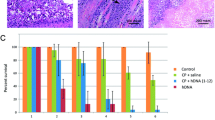Zusammenfassung
In der Bauchhöhle von Mäusen wachsende L5178 Y-Zellen wurden mit 125J-Joddeoxyuridin am 5. Tag des Tumorwachstums markiert zu einer Zeit, als der Einbau dieses DNS-Bausteines am intensivsten war. Um mit hohen Strahlendosen von 125J zusammenhängende Strahlenschäden zu vermeiden, überschritt die Dosis nicht 2 μCi pro Maus. Die markierten L5178Y-Zellen wurden danach in nicht radioaktive Mäuse transplantiert. Die Ausscheidung von 125J durch die neuen Wirtstiere wurde als Index für den Tod der Tumorzellen in vivo angenommen. In den Kontroll-Mäussen trat der Zelltod während der ersten 7–8 Tage des Tumorwachstums langsam ein, war aber in der Endphase beschleunigt. Die intraperitoneale Zufuhr von 0,4 Einheiten Asparaginase rief keine meßbare cytocide Wirkung hervor, während Dosen von 2 oder mehr Einheiten 98% oder höheren Zelltod innerhalb von 2 oder 3 Tagen nach der Injektion verursachten. Die Beurteilung der anatomischen Verteilung der Radioaktivität nach der Asparagin-Gabe zeigte, daß der Zelltod besonders schnell bei den in der Bauchhöhle befindlichen Tumorzellen erfolgte.
L5178Y-Zellen, welche die erste Behandlungsphase überlebt hatten, wurden neuerlich markiert, in neue Wirtstiere übertragen und einer zweiten Behandlung mit Asparaginase unterworfen. Tumorzellen, die mit 2 oder weniger Einheiten behandelt worden waren, blieben voll empfindlich gegenüber der Wirkung von Asparaginase, während Zellen entnommen von Mäusen welche mit 10 oder mehr Einheiten behandelt worden waren, sich als völlig unempfindlich gegenüber weiterer Asparaginase-Behandlung erwiesen.
Summary
L5178Y cells growing in the peritoneal cavity of mice were labeled with 125J-iododeoxyuridine on day 5 of tumor growth, when incorporation of this DNA precursor was most efficient. To avoid the radiation damage associated with high doses of 125J-iododeoxy-uridine, the labeling dose did not exceed 2 μCi per mouse. The labeled L5178Y cells were subsequently transplanted into nonradioactive mice. The excretion of 125J from the new hosts was taken as an index of tumor cell death in vivo. Cell death in control mice was slow during the first 7 or 8 days of tumor growth, but accelerated during the terminal phase. Intraperitoneal administration of 0.4 units of asparaginase produced no measurable cytocidal effects, whereas doses of two units or larger caused 98% or more cell killing within 2 or 3 days after drug injection. Evaluation of the anatomical distribution of radioactivity after drug administration revealed that cell death was especially rapid among tumor cells located in the peritoneal cavity.
L5178Y cells surviving the initial treatment were relabeled, transplanted into new hosts, and subjected to a second course of asparaginase treatment. Tumor cells that had been treated with two units or less remained fully sensitive to the action of asparaginase, while cells derived from mice treated with 10 units or larger doses proved to be completely insensitive to further administrations of asparaginase.
Similar content being viewed by others
References
Boyse, E. A., Old, L. J., Stockert, E.: Inhibitory effect of guinea pig serum on a number of new leukaemias in mice. Nature (Lond.) 198, 800 (1963).
Broome, J. D.: Evidence that the L-asparaginase activity of guinea pig serum is responsible for its antilymphoma effects. Nature (Lond.) 191, 1114 (1961).
—, Schwartz, J. H.: Differences in the production of L-asparagine in asparaginase-sensitive and resistant lymphoma cells. Biochim. Biophys. Acta 138, 637 (1967).
Commerford, S. L.: Biological stability of IUDR labeled with 125I after incorporation into the DNA of the mouse. Nature (Lond.) 206, 849 (1965).
Defendi, V., Manson, L. A.: Analysis of the life-cycle in mammalian cells. Nature (Lond.) 198, 359 (1963).
Hofer, K. G.: Tumor cell death in vivo after administration of chemotherapeutic agents. Cancer Chemother. Rept. 53, 273 (1969).
—: Radiation effects on death and migration of tumor cells in mice. Radiation Res. 43, 663 (1970).
—, Hughes, W. L.: Incorporation of 125I-iododeoxyuridine into the DNA of L1210 leukemia cells during tumor development. Cancer Res. 30, 236 (1970).
—, Prensky, W., Hughes, W. L.: Death and metastatic distribution of tumor cells in mice monitored with 125J-iododeoxyuridine. J. Natl. Cancer Inst. 43, 763 (1969).
Horowitz, B., Madras, B. R., Meister, B. K., Old, L. J.: Asparaginase synthetase activity of mouse leukemias. Science 160, 533 (1968).
Hughes, W. L., Commerford, S. L., Gitlin, D., Krueger, R. C., Schultze, B., Shah, V., Reilly, P.: Deoxyribonucleic acid metabolism in vivo: I. Cell proliferation and death as measured by incorporation and elimination of iododeoxyuridine. Fed. Proc. 23, 640 (1964).
Kidd, J. G.: Regression of transplanted lymphomas induced in vivo by means of normal guinea pig serum. I. Course of transplanted cancers of various kinds in mice and rats given guinea pig serum, horse serum or rabbit serum. J. Exptl. Med. 98, 565 (1953).
Mashburn, L. T., Wriston, J. C.: Tumor inhibitory effect of L-asparaginase from Escherichia coli. Arch. Biochem. Biophys. 105, 450 (1964).
Schein, P. S., Rakieten, N., Dordon, B. M., Davis, R. D., Rall, D. P.: The toxicity of Escherichia coli L-asparaginase. Cancer Res. 29, 426 (1969).
Skipper, H. E., Schabel, F. M., Wilcox, W. S.: Experimental evaluation of potential anticancer agents. XIV. Further study of certain basic concepts underlying chemotherapy of leukemia. Cancer Chemother. Rept. 45, 5 (1965).
Author information
Authors and Affiliations
Additional information
This investigation was supported by NIH Grant #CA10735-02.
Rights and permissions
About this article
Cite this article
Hofer, K.G., DiBenedetto, J. & Hughes, W.L. Natural and asparaginase induced death of L5178Y leukemia cells In vivo . Z Krebs-forsch 75, 34–44 (1970). https://doi.org/10.1007/BF00524742
Received:
Issue Date:
DOI: https://doi.org/10.1007/BF00524742




